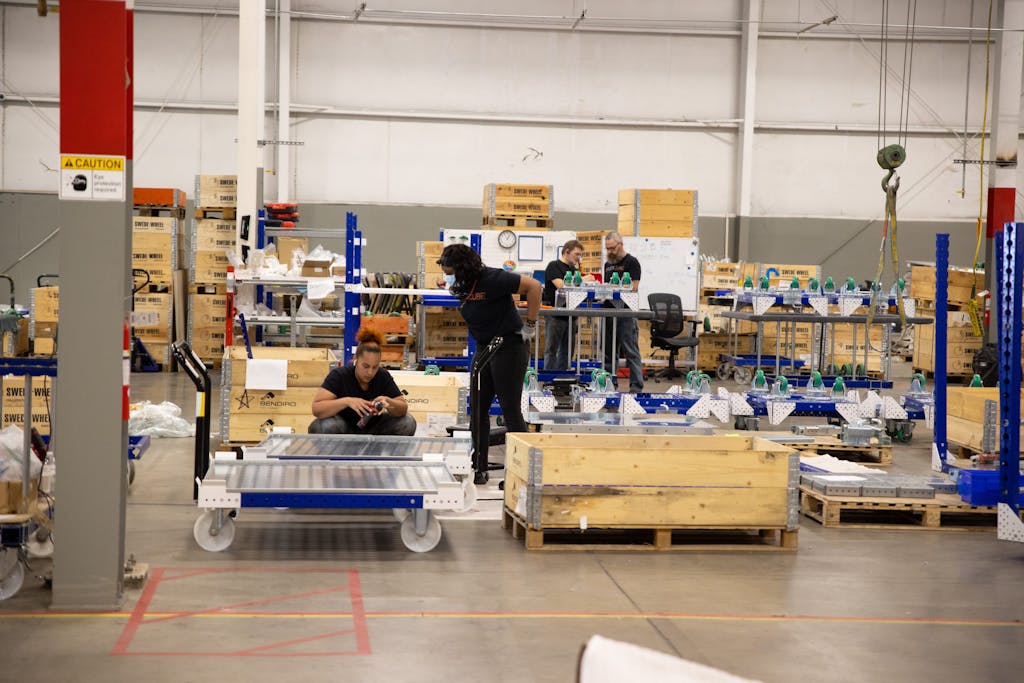HEIJUNKA: A Comprehensive Guide to Leveling Production

The concept of mass production popularized by Henry Ford and the Ford Motor Company solved the most important manufacturing question of its day – how does a manufacturer meet the increasing demand for its product?
The solution the Ford Motor Company came up with involved mass-producing similar items in batches, and for a time, this worked until customers requested Ford cars in different colors.
Henry Ford’s answer to customization requests remains famous to this day. The mercurial entrepreneur told its customers that they could have any color they wanted, as long as it was black. Today, such an answer will be met with derision and customers moving their business to competitors offering multiple colored vehicles. Limitations with batching meant that manufacturers like Ford struggled with meeting customization demands, assets and human resources ended up being overused, and capital was tied to large inventories that must be sold to turn a profit.
With increasing market demands, manufacturers had to look for a more effective process to satisfy customer requirements, and Toyota came up with an excellent solution termed Heijunka, pronounced hi-June-Kuh, which came with the following objectives:
- Reduce the workload on assets and human resources
- Maximize efficiency by reducing waste
- Reducing inventory stock
- Ensuring the continuous flow of materials within the supply chain
- Evening the peaks in production schedules
- Improve production capacity
What exactly is Heijunka?
Heijunka is defined as a lean manufacturing methodology that reduces unevenness in production cycles and product quality (Mura) while reducing the burden on machines and human resources (Muri), which, in turn, reduces waste (Muda). Generally, Heijunka reduces unevenness in production cycles by avoiding the application of batching and allowing manufacturers to apply a steady manufacturing pace that can deal with fluctuating customer demands.
The methodology Heijunka employs enables manufacturers to eliminate uneven production through two processes:
Leveling by Volume
To level production by volume, the manufacturer must first understand its demand cycle through accurate forecasting. Using demand forecasting applications and historical data, the manufacturer can determine the volume of orders it can expect in the future before applying leveling by volume Heijunka.
For example, a manufacturer pegs its weekly demand for yellow toy trains at 400, although the daily demand may fluctuate between 50 toy trains to 200 trains daily. Once the weekly demand has been established, production can be leveled by volume if the manufacturer produces 80 trains per day from Monday to Friday. Thus, days with orders lower than 80 toys will be filled, while the days with orders that exceed 80 will be filled using the difference in demand volume from other days.
Leveling by Product Type
For customers who offer multiple products with varied manufacturing requirements, leveling production by product type reduces the burden on production systems. In reality, the toy train manufacturer is more likely to receive multiple types of orders from customers. For example, customers’ demands can fluctuate weekly from 20 green trucks, 30 blue trucks, and 30 yellow trucks to 30 green trucks, 40 yellow trucks, and 20 blue trucks by the next week.
Batching cannot handle the aforementioned customized requests because it only reduces waste when mass-producing singular items with fixed features. A batching schedule will look like this; GGGGGBBBBYYY. This leads to overstocking on green trucks when customer demand fluctuates to increased orders for yellow trucks.
Leveling by volume also falls short as it focuses on volume, not differences in product features. However, leveling by product type enables the manufacturer to switch its production schedule to cater to changing requirements by emphasizing the more popular colors or items in demand.
Heijunka leveling by product type weekly schedule would look like this; GGBBYYBGGBBYY depending on the truck color currently in demand.
Implementing Heijunka on the Factory Floor
Since the inception of the production leveling concept by Toyota, the process of implementing Heijunka has been codified to enable any manufacturing enterprise to take advantage of the manufacturing agility it offers. Successfully implementing Heijunka starts with:
Predicting Customer Demand
Implementing Heijunka through the two methodologies outlined above requires having some understanding of your customer or product demand cycles. Accurate demand forecasts enable the manufacturer to know the volume of products to expect, and the expected fluctuations in the different product types demanded. Utilizing demand forecasting software helps with accurately understanding demand cycles to implement Heijunka.
Adopting Stabilizing Measures
Eliminating unevenness and instability is the major reason for implementing Heijunka. Thus, knowing your Takt time helps with developing an optimal production schedule to level production. Here, Takt time refers to the average time interval between the start of producing one unit and the start of producing the next during sequential production, Scheduling software utilizes Takt time, asset availability, available inventory, and production capacity to develop accurate schedules based on Heijunka.
Visualize Leveling with the Heijunka Box
The Heijunka box is a visualization tool used by Toyota to schedule production cycles and level out unevenness. Earlier Heijunka boxes were physical cards with slots divided into vertical and horizontal columns. The cards put into slots, called Kanban, represented product types and product quantities.
Vertical columns within the box represent time intervals that define when a product should be manufactured. The card is withdrawn at the appropriate time to start the production process. The horizontal row represents the type of product to be produced, and the card in each box equals ‘one pitch’. Here, pitch means the amount of time required to make a batch of products.
Buffer Inventory
The leveling of production volume reduces the burden on the manufacturing system and ensures the manufacturing enterprise has a number of products available for each day. Leveling production, in this case, eliminates waste while keeping customers happy.
Conclusion
Applying Heijunka reduces waste and minimizes the burden on a manufacturing enterprise’s assets, inventory, and human resources. Leveling production reduces equipment wear, improves material use, and increases customer satisfaction levels.


